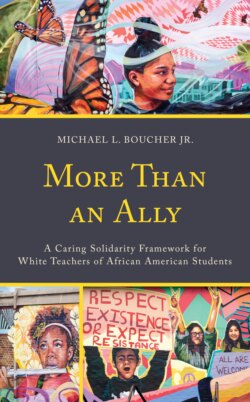Читать книгу More Than an Ally - Michael L. Boucher Jr. - Страница 12
На сайте Литреса книга снята с продажи.
Caring Solidarity, Race,
Teachers, and Schools
ОглавлениеThe framework of caring solidarity addresses both the mind-sets that allow a person to move toward caring solidarity and also the skills of empathy, alliance, and being an accomplice. As Katsarou, Picower, and Stovall (2010) stated, “to truly teach in solidarity with schools and communities requires of teachers both specific mindsets and skill sets” (p. 152). This framework addresses critical perspectives on solidarity that include White allies (Patel, 2011), false empathy (Delgado, 1996; Warren & Hotchkins, 2014), and White savior syndrome (Straubhaar, 2014). Caring solidarity asks teachers to delve deeply into their own position and explore the mechanisms, conditions, and mental commitments necessary to do that work.
As communities of color come under increasing attack from above and below, teachers must be the vanguard of equity and diversity in our schools and our society. Caring solidarity is situated in second-wave White teacher–identity studies (Jupp, Berry, & Lensmire, 2016) and is applied to students and teachers. However, the majority of the theoretical basis for the framework comes from scholarship done by African American scholars in elementary school settings. Their insights are crucial to the construction of the theories behind the framework, and they are quoted and cited widely in this book.
Caring solidarity framework.
This new framework is rooted in critical theory, critical whiteness studies, and multicultural understandings, but seeks to move to a deeper commitment that will allow White teachers to meet the deep challenges of the present age and usher in a new one that fulfills the promise of an equitable, empowering, and democratic education for all of our students. The theoretical work relies on culturally relevant and sustaining pedagogies and seeks to be an extension or precursor needed for White teachers to build solidarity with Black students. It is also meant to be a mechanism to more fully integrate these frameworks into daily teaching.
The caring solidarity framework is meant to be both descriptive of teachers who seek solidarity across the color line and aspirational for teachers seeking to create classrooms where Black students know they are valued and learn to thrive. It asks White teachers to deeply examine their roles, positions, ideas, and methods used when they teach African American students. Caring and solidarity are concepts that have been explored separately and tangentially in education for decades but have not been placed together as a specific way to describe the effort of teachers who work across the color line.
These first few chapters summarize some of that research to give a portrait of how schools disempower and disenfranchise Black students. It begins with discussion of the current White teaching force and race. The second chapter explains the imperative of the moment with an outline of the deepest moral failure of our schools, the school to prison pipeline. The third chapter reviews the concept of multicultural education and its ineffectiveness to meet the current challenges. The conversation then turns to ways to meet the challenges and begins the move from allyship and other asset pedagogies to a new framework of caring solidarity.
No other profession has the potential to reshape and redirect this age where science, reason, and equality have been all but abandoned. Teachers can effect societal change through their work in and out of classrooms. They can expose their students to truths that are unavailable to them anywhere else. Teachers are world changers, and teaching effectively is essential to creating needed change in the country, the world, and our communities.
